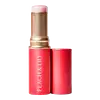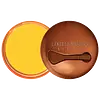What's inside
What's inside
 Key Ingredients
Key Ingredients

 Benefits
Benefits

 Concerns
Concerns

 Ingredients Side-by-side
Ingredients Side-by-side

Diisostearyl Malate
EmollientOctyldodecanol
EmollientPolyisobutene
Synthetic Wax
AbrasiveCopernicia Cerifera Wax
Glycerin
HumectantCamellia Japonica Seed Oil
EmollientButyrospermum Parkii Butter
Skin ConditioningGlyceryl Glucoside
HumectantSqualane
EmollientTremella Fuciformis Polysaccharide
Emulsion StabilisingAlpha-Glucan Oligosaccharide
CleansingGlucose
HumectantCollagen Extract
Skin ConditioningPanax Ginseng Root Extract
EmollientHordeum Distichon Extract
Skin ProtectingHouttuynia Cordata Extract
Skin ConditioningPrunus Persica Leaf Extract
EmollientBifida Ferment Filtrate
Skin ConditioningVitis Vinifera Fruit Extract
Skin ConditioningArtemisia Vulgaris Extract
Skin ConditioningPanthenol
Skin ConditioningTremella Fuciformis Extract
HumectantHydrolyzed Sodium Hyaluronate
Skin ConditioningSodium Hyaluronate
HumectantHydrolyzed Hyaluronic Acid
HumectantHyaluronic Acid
HumectantSodium Hyaluronate Crosspolymer
HumectantPalmitoyl Tripeptide-1
Skin ConditioningAcetyl Hexapeptide-8
HumectantTripeptide-1
Skin ConditioningCopper Tripeptide-1
Skin ConditioningAcetyl Tetrapeptide-5
HumectantPalmitoyl Pentapeptide-4
Skin ConditioningHexapeptide-9
Skin ConditioningNonapeptide-1
Skin ConditioningDipeptide-2
Skin ConditioningLecithin
EmollientRosa Canina Seed Extract
EmollientWater
Skin ConditioningHelianthus Annuus Seed Oil
EmollientAdenosine
Skin ConditioningTocopherol
AntioxidantButylene Glycol
HumectantHibiscus Rosa-Sinensis Flower Extract
HumectantSantalum Album Extract
Cleansing1,2-Hexanediol
Skin ConditioningEthylhexylglycerin
Skin ConditioningCaprylyl Glycol
EmollientPhellodendron Amurense Bark Extract
Skin ConditioningChlorella Ferment
Skin ConditioningPolyglyceryl-10 Oleate
Skin ConditioningPentylene Glycol
Skin ConditioningMica
Cosmetic ColorantTitanium Dioxide
Cosmetic ColorantTitanium/Titanium Dioxide
Cosmetic ColorantTin Oxide
AbrasiveCI 77491
Cosmetic ColorantDiisostearyl Malate, Octyldodecanol, Polyisobutene, Synthetic Wax, Copernicia Cerifera Wax, Glycerin, Camellia Japonica Seed Oil, Butyrospermum Parkii Butter, Glyceryl Glucoside, Squalane, Tremella Fuciformis Polysaccharide, Alpha-Glucan Oligosaccharide, Glucose, Collagen Extract, Panax Ginseng Root Extract, Hordeum Distichon Extract, Houttuynia Cordata Extract, Prunus Persica Leaf Extract, Bifida Ferment Filtrate, Vitis Vinifera Fruit Extract, Artemisia Vulgaris Extract, Panthenol, Tremella Fuciformis Extract, Hydrolyzed Sodium Hyaluronate, Sodium Hyaluronate, Hydrolyzed Hyaluronic Acid, Hyaluronic Acid, Sodium Hyaluronate Crosspolymer, Palmitoyl Tripeptide-1, Acetyl Hexapeptide-8, Tripeptide-1, Copper Tripeptide-1, Acetyl Tetrapeptide-5, Palmitoyl Pentapeptide-4, Hexapeptide-9, Nonapeptide-1, Dipeptide-2, Lecithin, Rosa Canina Seed Extract, Water, Helianthus Annuus Seed Oil, Adenosine, Tocopherol, Butylene Glycol, Hibiscus Rosa-Sinensis Flower Extract, Santalum Album Extract, 1,2-Hexanediol, Ethylhexylglycerin, Caprylyl Glycol, Phellodendron Amurense Bark Extract, Chlorella Ferment, Polyglyceryl-10 Oleate, Pentylene Glycol, Mica, Titanium Dioxide, Titanium/Titanium Dioxide, Tin Oxide, CI 77491
Caprylic/Capric Triglyceride
MaskingCamellia Japonica Seed Oil
EmollientSimmondsia Chinensis Seed Oil
EmollientGarcinia Indica Seed Butter
Skin ConditioningOctyldodecanol
EmollientJojoba Esters
EmollientLauroyl Lysine
Skin ConditioningHelianthus Annuus Seed Wax
Skin ConditioningButyrospermum Parkii Butter
Skin ConditioningHelianthus Annuus Seed Oil
EmollientSqualane
EmollientDibutyl Ethylhexanoyl Glutamide
Skin ConditioningDibutyl Lauroyl Glutamide
Skin ConditioningSilica
AbrasiveHippophae Rhamnoides Fruit Oil
Skin ProtectingSodium Hyaluronate
HumectantCentella Asiatica Leaf Extract
Skin ConditioningTanacetum Annuum Flower Oil
MaskingCamellia Sinensis Leaf Powder
ExfoliatingSpirulina Platensis Extract
Skin ProtectingHoya Lacunosa Flower Extract
Skin ConditioningOpuntia Ficus-Indica Extract
Skin ConditioningGlucomannan
Skin ConditioningAcacia Decurrens Flower Wax
EmollientPrunus Amygdalus Dulcis Oil
Skin ConditioningTocopheryl Acetate
AntioxidantTrihydroxystearin
Skin ConditioningEthylhexyl Palmitate
EmollientPolyglycerin-3
HumectantHydrogenated Vegetable Oil
EmollientCaprylic/Capric Triglyceride, Camellia Japonica Seed Oil, Simmondsia Chinensis Seed Oil, Garcinia Indica Seed Butter, Octyldodecanol, Jojoba Esters, Lauroyl Lysine, Helianthus Annuus Seed Wax, Butyrospermum Parkii Butter, Helianthus Annuus Seed Oil, Squalane, Dibutyl Ethylhexanoyl Glutamide, Dibutyl Lauroyl Glutamide, Silica, Hippophae Rhamnoides Fruit Oil, Sodium Hyaluronate, Centella Asiatica Leaf Extract, Tanacetum Annuum Flower Oil, Camellia Sinensis Leaf Powder, Spirulina Platensis Extract, Hoya Lacunosa Flower Extract, Opuntia Ficus-Indica Extract, Glucomannan, Acacia Decurrens Flower Wax, Prunus Amygdalus Dulcis Oil, Tocopheryl Acetate, Trihydroxystearin, Ethylhexyl Palmitate, Polyglycerin-3, Hydrogenated Vegetable Oil
Alternatives
Ingredients Explained
These ingredients are found in both products.
Ingredients higher up in an ingredient list are typically present in a larger amount.
This ingredient is also known as shea butter. It is an effective skin hydrator and emollient.
Emollients help soothe and soften your skin. It does this by creating a protective film on your skin. This barrier helps trap moisture and keeps your skin hydrated. Emollients may be effective at treating dry or itchy skin.
Shea butter is rich in antioxidants. Antioxidants help fight free-radicals, or molecules that may harm the body. It is also full of fatty acids including stearic acid and linoleic acid. These acids help replenish the skin and keep skin moisturized.
While Shea Butter has an SPF rating of about 3-4, it is not a sunscreen replacement.
Shea butter may not be fungal acne safe. We recommend speaking with a professional if you have any concerns.
Learn more about Butyrospermum Parkii ButterCamellia Japonica Seed Oil comes from the Japanese Camellia plant. This plant is native to East Asia and known as "Tsubaki" in Japanese.
Camellia Japonica Seed Oil is rich in oleic acid. This makes it a great emollient. Emollients help soften and soothe the skin by forming a barrier. This barrier traps moisture within, keeping your skin hydated.
Helianthus Annuus Seed Oil is the oil derived from the seeds of a Sunflower. Sunflower seed oil is non-fragrant. It is an emollient, meaning it helps to soften the skin.
Sunflower seed oil contains many fatty acids. The fatty acids found in sunflower seeds include (from highest amount to least): linoleic acid, myristic acid, palmitic acid, stearic acid, arachidic acid, oleic acid, and linolenic acid.
These fatty acids help the skin create ceramides. Ceramides play a role in repairing the skin barrier.
Helianthus Annuus Seed Oil helps moisturize the skin. This in turn helps the skin look more rejuvenated and smoother.
Sunflowers are rich in vitamin E.
Historians believe Indigenous cultures of North America domesticated sunflowers before corn. Thus they relied on sunflower oil for a variety of uses. One such use is moisturizing skin and hair.
Sunflower seed oil may not be fungal acne safe. We recommend speaking with a professional if you have any concerns.
Learn more about Helianthus Annuus Seed OilOctyldodecanol is a fatty alcohol. It is primarily used to enhance the texture of products.
As an emulsifier, Octyldodecanol helps prevent the oils and waters from separating. It also prevents ingredients from creating foam when shaken.
Octyldodecanol is created by reducing fatty acid to an alcohol.
Due to its high molecular weight, it does not get absorbed into the skin.
Learn more about OctyldodecanolSodium Hyaluronate is hyaluronic acid's salt form. It is commonly derived from the sodium salt of hyaluronic acid.
Like hyaluronic acid, it is great at holding water and acts as a humectant. This makes it a great skin hydrating ingredient.
Sodium Hyaluronate is naturally occurring in our bodies and is mostly found in eye fluid and joints.
These are some other common types of Hyaluronic Acid:
Learn more about Sodium HyaluronateSqualane is an emollient that helps the skin hold onto moisture. It's an oily liquid that occurs naturally in certain types of fish and plant oils.
Because squalane boosts hydration in the skin, it also comes with plenty of benefits: it is an antioxidant and can help fight free radicals and skin damage. Squalane is also found to have a detoxifying effect when applied.
Squalane comes from squalene, which occurs naturally within the sebum of our skin. It is one of the oils our skin produces to keep itself hydrated. Squalane is the hydrogenated version of squalene and has a longer shelf life.
Research shows that squalane is non-irritating (even at 100% concentration).
In general, it's a fantastic ingredient. It does a great job at hydrating the skin, and it's suitable for those with sensitive skin.
The source of squalane may impact malassezia / fungal acne. This is because olive oil derived squalane can contain impurities such as fatty acids and plant waxes. Sugarcane derived squalane is recommended for anyone with malassezia concerns.
Is squalane vegan?
This depends on the source. Squalane can be derived from both plants and animals. Most squalane used in skincare comes from plants.
Please note: the source of squalane is only known if disclosed by the brand. We recommend reaching out to the brand if you have any questions about their squalane.
Read more about squalene with an "e".
Is squalane an oil?
Squalane is often called an oil, but it’s technically not; it’s a hydrocarbon, meaning it’s only made of carbon and hydrogen, unlike true oils which are triglycerides made of fatty acids and glycerol.
The term “oil-free” isn’t regulated, so companies can define it however they want. Some exclude all oils, while others just avoid mineral oil or comedogenic oils.
While some people avoid oils thinking they cause breakouts, the right kind of oil (or oil-like ingredient like squalane) can actually help balance and hydrate your skin. It’s worth testing out simple oils or squalane to see what works best for your skin.
Learn more about Squalane